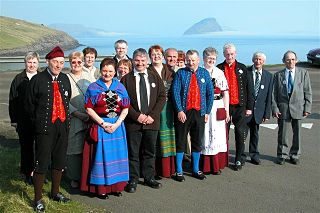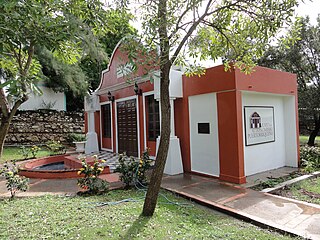Related Research Articles

Tuxtla Gutiérrez is the capital and the largest city of the Mexican southeastern state of Chiapas. It is the seat of the municipality of the same name, the most developed and populated in the state. A busy government, commercial and services-oriented city, Tuxtla had one of the fastest-growing rates in Mexico in the last 40 years. Unlike many other areas in Chiapas, it is not a major tourist attraction, but a transportation hub for tourists coming into the state, with a large airport and a bus terminal.

San Cristóbal de las Casas, also known by its native Tzotzil name, Jovel, is a town and municipality located in the Central Highlands region of the Mexican state of Chiapas. It was the capital of the state until 1892, and is still considered the cultural capital of Chiapas.

A folk costume expresses an identity through costume, which is usually associated with a geographic area or a period of time in history. It can also indicate social, marital or religious status. If the costume is used to represent the culture or identity of a specific ethnic group, it is usually known as ethnic costume. Such costumes often come in two forms: one for everyday occasions, the other for traditional festivals and formal wear.

Cristóbal Balenciaga Eizaguirre was a Spanish fashion designer, and the founder of the Balenciaga fashion house. He had a reputation as a couturier of uncompromising standards and was referred to as "the master of us all" by Christian Dior and as "the only couturier in the truest sense of the word" by Coco Chanel, who continued, "The others are simply fashion designers". On the day of his death, in 1972, Women's Wear Daily ran the headline "The King is Dead".

A pollera is a Spanish term for a big one-piece skirt used mostly in traditional festivities and folklore throughout Spanish-speaking Latin America. Polleras are made from different materials, such as cotton or wool and tend to have colorful decorations. Most of the decorations are embroidered, flowers and regional animals are among the most common designs found in polleras.

Baile folklórico, literally "folkloric dance" in Spanish, also known as ballet folklórico, is a collective term for traditional cultural dances that emphasize local folk culture with ballet characteristics – pointed toes, exaggerated movements, highly choreographed. Baile folklórico differs from danzas and regional bailes. "Folk dances", that is, "dances that you will find in the villages, not on stage" were researched and disseminated by Alura Angeles de Flores. Each region in Mexico, the Southwestern United States and Central American countries is known for a handful of locally characteristic dances.

The baro’t saya or baro at saya is a traditional dress ensemble worn by women in the Philippines. It is a national dress of the Philippines and combines elements from both the precolonial native Filipino and colonial Spanish clothing styles. It traditionally consists of four parts: a blouse, a long skirt, a kerchief worn over the shoulders, and a short rectangular cloth worn over the skirt.

Sergio Arturo Castro Martínez is a Mexican humanitarian who resides in San Cristóbal de las Casas, Chiapas, Mexico.
The Ixchel Museum of Indigenous Textiles and Clothing is a museum in Guatemala City, Guatemala. The museum explores the Guatemalan traditions of dress throughout the country and also has notable collections of ceramics, textiles, jewelry and books. The museum is housed on the campus of Francisco Marroquin University.
España y Filipinas is a series of oil on wood paintings by Filipino painter, ilustrado, and revolutionary activist, Juan Luna. It is an allegorical depiction of two women together, one a representation of Spain and the other of the Philippines. The painting, also known as España Guiando a Filipinas, is regarded as one of the “enduring pieces of legacy” that the Filipinos inherited from Luna.

The María Clara gown, an erroneous term for Filipiniana dress or the Spanish colonial era traje de mestiza, is a type of traditional dress worn by women in the Philippines. It is an aristocratic version of the baro't saya. It takes its name from María Clara, the mestiza protagonist of the novel Noli Me Tángere, penned in 1887 by Filipino nationalist José Rizal. It is traditionally made out of piña, the same material used for the barong tagalog.

The Regional Museum of Anthropology and History of Chiapas is the largest museum in Tuxtla Gutiérrez in Chiapas and one of the most important of its kind in Mexico. It primarily consists of two main halls with one dedicated to the state’s Mesoamerican archeology and the other to the history of the state starting from the Spanish conquest. The archeological display focus on the native Zoque and Mayan cities, and the historical displays extend in time until the early 20th century. In addition to its permanent collection, it also has a temporary exhibit hall and auditorium to host events such as book signings, summer classes, conferences and more.

The former monastery of Santo Domingo/Museo de la Laca is located in the city of Chiapa de Corzo, Chiapas, Mexico. The monastery with its church was built in the 16th century, with the monastery secularized later. The church retains its original function. The building with two courtyards was restored between 1999 and 2002 to become a community and cultural center, with the Museo de la Laca, founded in 1952, moved inside to take up much of the upper floor. This museum contains about 450 pieces from various parts of Mexico and Asia, mostly made in the 20th century. The complex also contains halls with permanent and temporary exhibits along with an auditorium and various types of workshops.

Museo Universitario de Artes Populares María Teresa Pomar is a museum dedicated to Mexico's handcrafts and folk art tradition, called “artesanía.” It is part of the University of Colima in the city of Colima, founded by artesanía collector and promoter María Terea Pomar. It contains one of the most important collections of its type in Mexico, covering traditions from around the country as well as the artesanía and traditions of the state of Colima.

The Museo Regional de la Cerámica in Tlaquepaque, Jalisco, Mexico is located on Independencia Street in the center of the city. The museum is one of two main ceramics museums in the city, with the other being the Pantaleon Panduro Museum. It was established in 1954 to preserve and promote indigenous handcrafts of Jalisco, especially the state’s ceramic tradition. The emphasis is still on ceramics but the museum also has a room dedicated to Huichol art and holds events related to various types of indigenous crafts and culture.

The Museum of Garment - Ethnologic Heritage Research Center is a museum located in Madrid, Spain, with collections devoted to fashion and costumes. The museum has over 160,000 pieces and documents. The current building was completed in 1973. Collections date from the Middle Ages up to clothes by Spain's contemporary fashion designers. It was declared Bien de Interés Cultural in 1962.

Folk dance of Mexico, commonly known as baile folklorico or Mexican ballet folk dance, is a term used to collectively describe traditional Mexican folk dances. Ballet folklórico is not just one type of dance, it encompasses each region's traditional dance that has been influenced by their local folklore and has been entwined with ballet characteristics to be made into a theatrical production. Each dance represents a different region in Mexico illustrated through their different zapateado, footwork, having differing stomps or heel toe points, and choreography that imitates animals from their region such as horses, iguanas, and vultures.

The Museo del Autonomismo Puertorriqueño is a small museum in Ponce, Puerto Rico, that showcases the political history of Puerto Rico with an emphasis on the contributions made by the municipality of Ponce and its residents. The museum was established on 7 September 2006.

Marta Turok is a Mexican applied anthropologist focusing on socio-economic development, and one of the foremost schools on Mexican folk art. Through research, government work, education and advocacy, she has worked to raise the prestige of Mexican handcrafts and folk art and to help artisans improve their economic status. Her work has been recognized with awards from various governmental and non-governmental agencies.

Ruth Matilda Anderson was an American photographer and author, known for her ethnographical photographs and studies of mainly rural life in early 20th-century Spain. During her extended field trips to regions of Spain from the 1920s to the late 1940s, commissioned by the Hispanic Society of America (HSA), she took thousands of photographs and accompanying notes on Spanish life and people. This led to her appointment as Curator of Photography at the Hispanic Society in 1922. From 1954 until her retirement, she continued her career as Curator of Costumes at the HSA, authoring books on Spanish historical and folk costumes.
References
- ↑ Acevedo, Alberto (september 20 2009). «Sergio Castro». El Heraldo de Chihuahua. Accessed December 5, 2014.
- ↑ «Museo de Trajes Regionales Sergio Castro». Conaculta.gob.mx. Accessed December 5, 2014.
Stichting Chiapas Indianen - Dutch foundation supporting the work of Sergio Castro